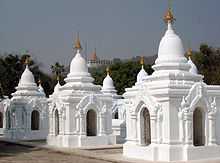Pagodas in Burma
From Wikipedia, the free encyclopedia

Shwedagon in Yangon
Pagodas in Burma (or Myanmar) are tiered structures for Buddhist religious purposes; the Burmese word is ဘုရား (MLCTS bhu.ra:; pronounced [pʰəjá]). Theravada Buddhism is the religion of the majority of Burma's population (90%). In all parts of the country where the Burmese people live there are pagodas and Buddhist monasteries. The graceful tapering shape of a pagoda painted white or gilded to a shining gold, is a basic part of any Burmese landscape. Burma is often called the "Land of Pagodas". Following are some lists of pagodas.
- Yangon (formerly Rangoon)
- Shwedagon Pagoda
- Sule Pagoda
- Botahtaung Pagoda
- Kaba Aye Pagoda
- Chauk Htat Kyi
- Koe Htat Kyi
- Mae Lamu Pagoda
- Kyauktawgyi
- Kyaikkalo and Kyaikkalei

Kuthodaw
Mandalay is a cultural and religious center of Buddhism, having many monasteries and more than 700 pagodas.
- Mahamuni Buddha
- Shwenandaw Monastery
- Kuthodaw Pagoda
- Sandamuni
- Shwe Kyi Myin
- Atumashi Monastery
- Kyauktawgyi Paya Pagoda
- Mandalay Hill

Bagan Pagodas
- Bagan (formerly Pagan). UNESCO has long tried unsuccessfully to designate Bagan as a World Heritage Site due to many ancient pagodas.
- Nyaung U & Wetkyi-in
- Shwezigon Pagoda
- Htilominlo Temple
- Gubyaukgyi Temple
- Manuha Temple
- Nagayon Temple
- Gubyaukgyi Temple
- Seinnyet Nyima Paya & Seinnyet Ama Pahto
- Lawkananda Pagoda
- Leimyethna Temple
- Dhammayazika Pagoda
- Around Bagan
- Mawlamyaing (formerly Moulmein)
- Mrauk U
- Andaw Temple
- Shitthaung Temple
- Htukkanthein Temple
- Koethaung Pagoda
- Pitakataik
- Laymyetnha Pagoda
- Shwe Daung Pagoda
- Archaeological Museum
See also
External links
This article is issued from Wikipedia. The text is available under the Creative Commons Attribution/Share Alike; additional terms may apply for the media files.